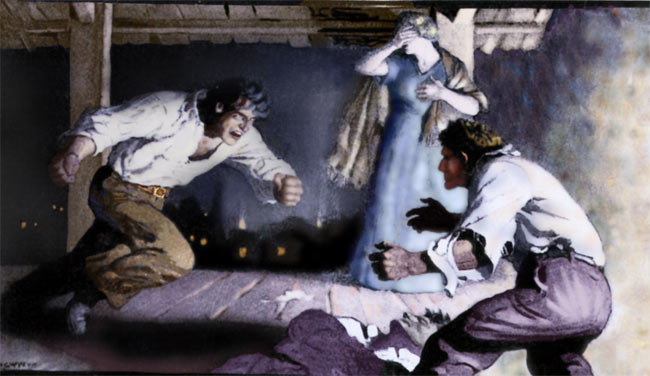X-rays Expose N.C. Wyeth Painting Hidden Under Another

A new X-ray imaging technique has revealed colorful details of a painting hidden beneath another painting by famed American artist N.C. Wyeth, whose iconic work appeared in popular magazines like the Saturday Evening Post.
The so-called lost illustration depicts a dramatic fist fight, which was published in a 1919 article in Everybody's Magazine, titled "The Mildest Mannered Man." Previously, scientists had used X-rays to show the artist, Newell Convers Wyeth (1882-1945), had covered the fight scene with another painting called "Family Portrait."
But that work only revealed the illustration in black-and-white. The scientists weren't even sure the hidden artwork was in color.
"One of the surprises was that the painting was in color at all," Jennifer Mass, senior scientist at the Winterthur Museum in Delaware, told LiveScience. "When N.C. Wyeth was making a painting for an illustration, if he knew it was going to be reproduced in black-and-white, sometimes he just did the paintings in shades of gray."
Mass, who is also an adjunct professor at the University of Delaware, will present the findings today at the National Meeting of the American Chemical Society in Washington, D.C.
Mass and her colleagues shot intense X-ray beams at the painting using a so-called confocal X-ray fluorescence microscope. The instrument then collected the X-rays that were emitted by different chemical elements in the painting's pigments. Each element gives off a certain intensity of X-rays. And since certain elements were used to make pigments, the researchers could translate the X-ray measurements into color. For instance, cobalt would indicate a blue pigment, while chromium would signal a yellow or green color, Mass said.
The result was a full-color representation of the hidden painting.
Sign up for the Live Science daily newsletter now
Get the world’s most fascinating discoveries delivered straight to your inbox.
The non-destructive method could uncover other famous artwork veiled beneath second paintings by Wyeth and others, the researchers say.
Many famous artists re-used their canvases, sometimes covering one great painting with another, in order to save money or for artistic purposes — to let the colors and shapes of one piece of work influence the next one, Mass said.
For instance, Vincent van Gogh may have painted over his work up to a third of the time. In fact, so-called X-ray radiography recently revealed a portrait of a woman beneath van Gogh's "Patch of Grass."
Technology has brought other aspects of great artists' work to life. For example, computers recently revealed how Claude Monet, known to have suffered from impaired vision, would have seen his own artwork.
Even Mona Lisa has gotten a boost from technology. Scientists scanned the painting with a camera that uses 13 wavelengths of light (from ultraviolet to infrared), peeling away centuries of varnish and other alterations. The result: They found Leonardo da Vinci had given his subject eyebrows.
Jeanna Bryner is managing editor of Scientific American. Previously she was editor in chief of Live Science and, prior to that, an editor at Scholastic's Science World magazine. Bryner has an English degree from Salisbury University, a master's degree in biogeochemistry and environmental sciences from the University of Maryland and a graduate science journalism degree from New York University. She has worked as a biologist in Florida, where she monitored wetlands and did field surveys for endangered species, including the gorgeous Florida Scrub Jay. She also received an ocean sciences journalism fellowship from the Woods Hole Oceanographic Institution. She is a firm believer that science is for everyone and that just about everything can be viewed through the lens of science.









